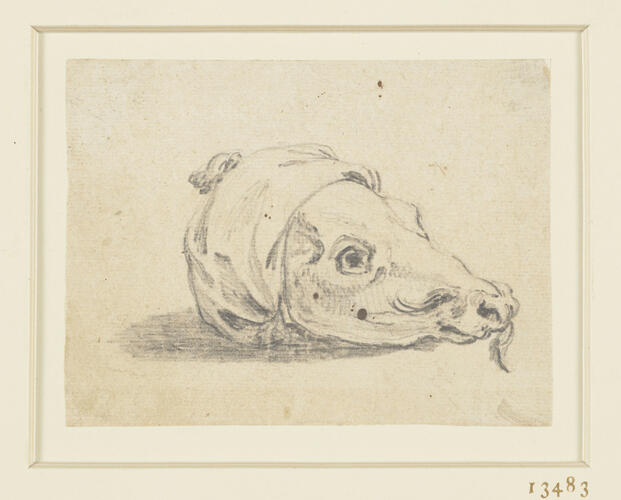-
1 of 253523 objects
The Calf's Head c. 1735
Pencil | 9.0 x 11.7 cm (sheet of paper) | RCIN 913483

Attributed to John van der Gucht (1697-1776)
The Calf's Head c. 1735
-
A pencil drawing of a calf's head, with a moustache and beard resembling those of Charles I.
The drawing relates to a print of the Calves' Head Club attributed to John van der Gucht and published in 1735 (for an impression, see British Museum 1868,0808.3570). In the print, men gather around a calf's head on a table, while a bonfire blazes outside. The print records a meeting of the Calves' Head Club, a group of pro-Republican supporters that emerged in seventeenth century, to mock the memory of Charles I. The calf's head was a symbol of the beheaded king, exaggerated here by the facial hair. Other activities are said to have included the burning of copies of the Eikon Basilike. By the eighteenth century, other Whig dining societies included the Sublime Society of Beefsteaks, albeit promoting values of liberty and freedom, rather than anti-monarchist tendencies. The Calves' Head Club folded in 1734, after a meeting in which, according to the Weekly Oracle on 1 February 1735:
Thursday in the evening a disorder of a very particular nature happened in Suffolk-street: 'Tis said that several young gentlemen of distinction having met at a house there, call'd themselves the Calf’s-Head Club; and about seven o’clock a bonfire being lit up before the door, just when it was in the height, they brought a calf's-head to the window dress'd in a napkin-cap, and after some Huzza's, threw it into the fire: The mob were entertained with strong-beer, and for some time halloo'd as well as the best; but taking a disgust at some healths which were proposed, grew so outrageous, that they broke all the windows, forc'd themselves into the house, and would probably have pull'd it down, had not the Guards been sent for to prevent further mischief. The damage done within and without the house, is computed at some hundred pounds. The Guards were posted all night in the street, for the security of the neighbourhood.
This drawing is mounted with a design for the whole print (RCIN 913484). Although Samuel Ireland believed both drawings to be by Hogarth, they are more likely to be by Van der Gucht in preparation for the print.Provenance
Samuel Ireland; Standly sale 1845, lot 911; bought Colnaghi (£3 13s. 6d.); acquired by Queen Victoria
-
Creator(s)
Acquirer(s)
-
Medium and techniques
Pencil
Measurements
9.0 x 11.7 cm (sheet of paper)
Category
Object type(s)
Other number(s)
RL 13483